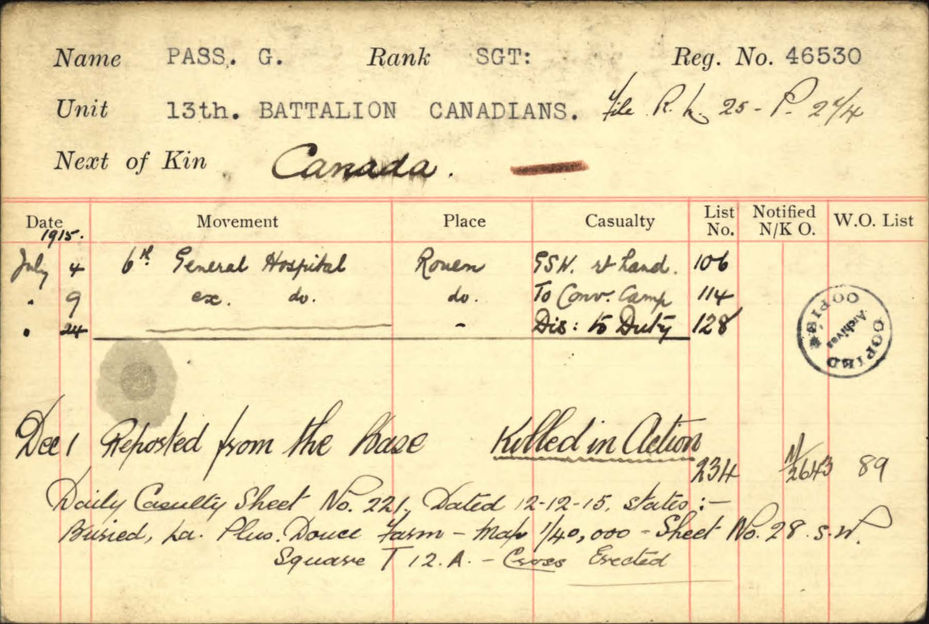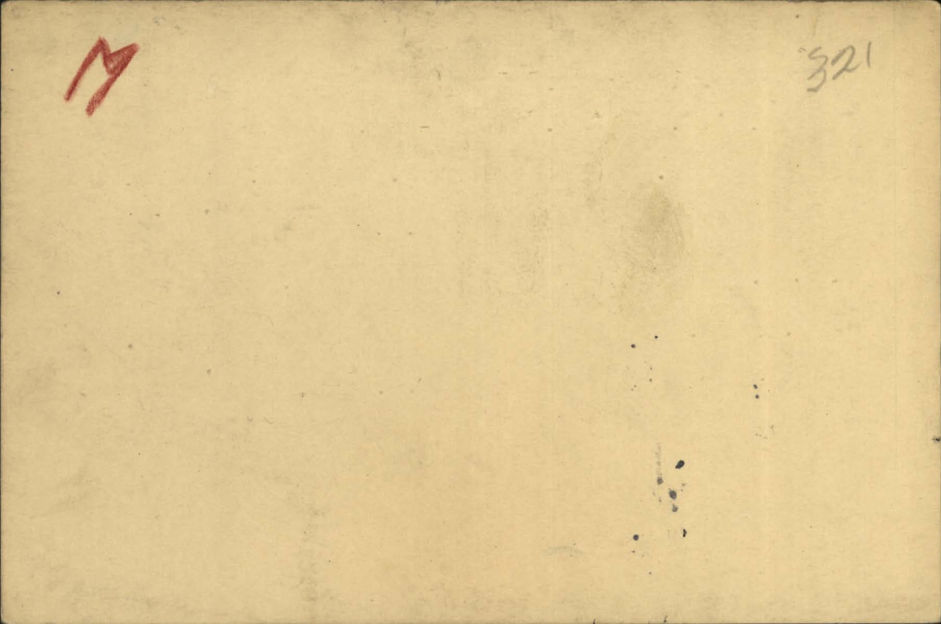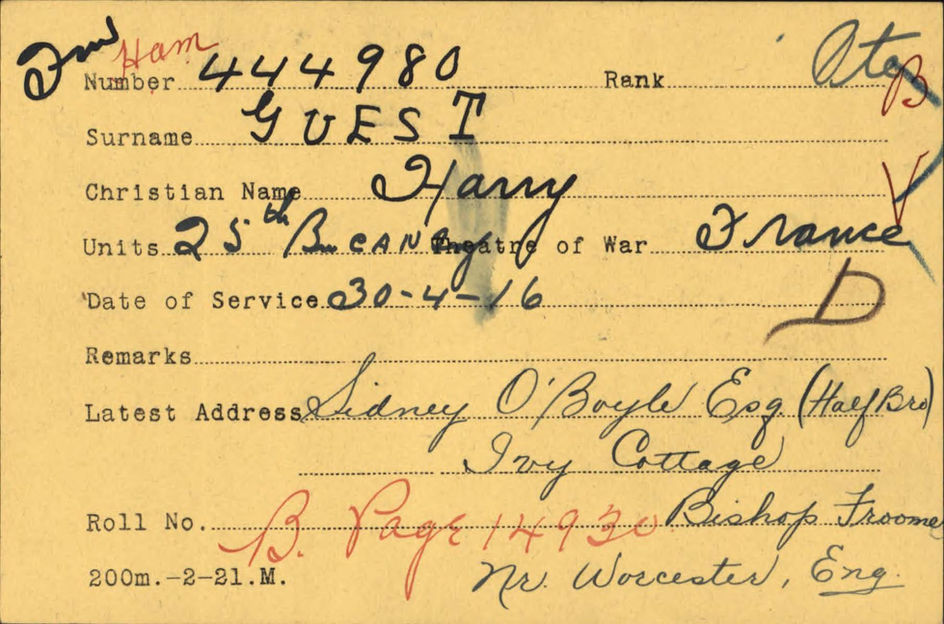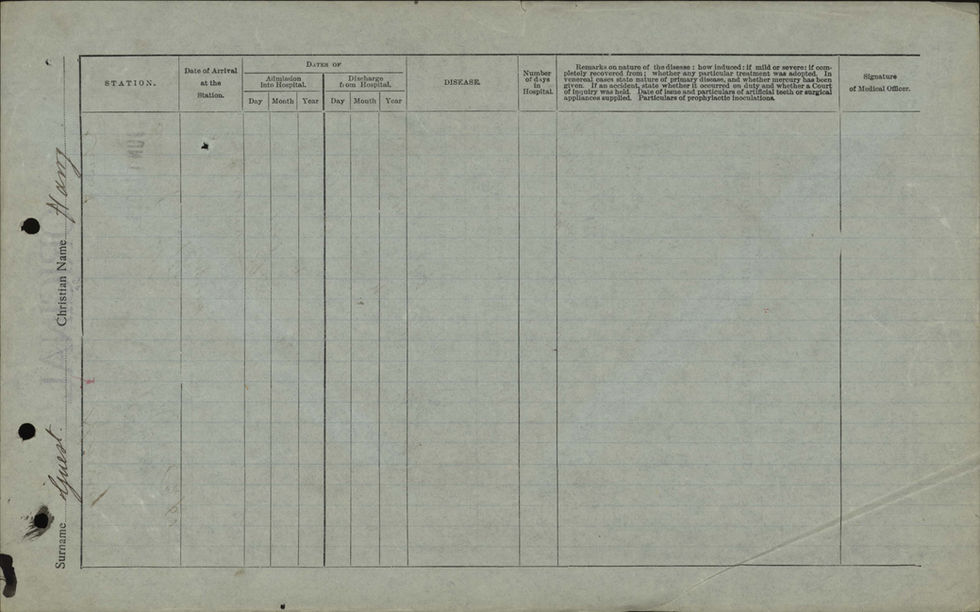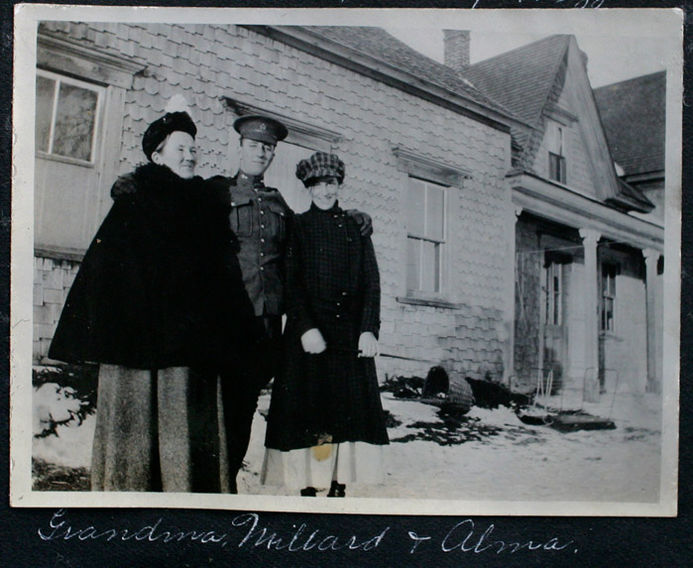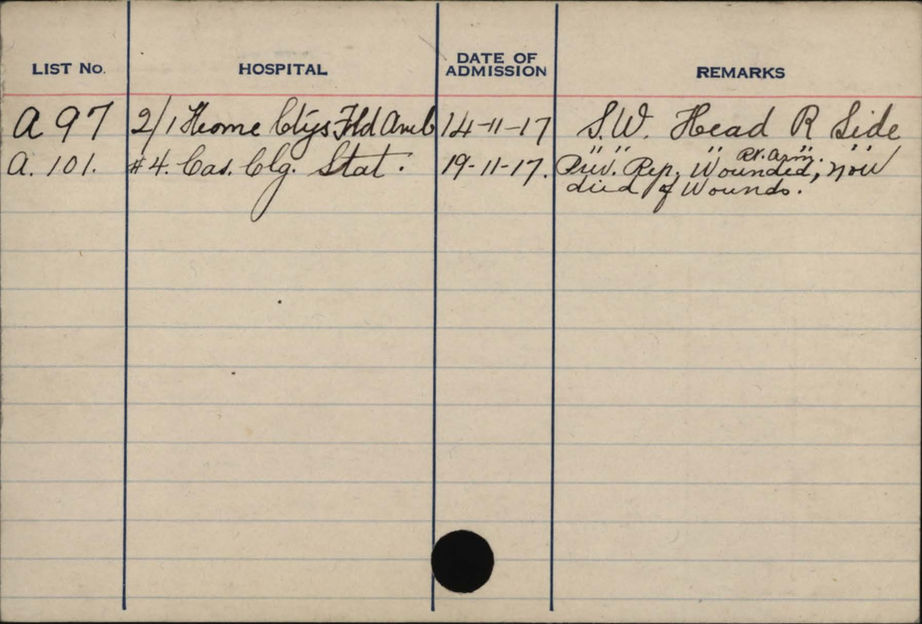Harvey Cenotaph
A large number of Harvey area residents have served, and continue to serve with the Canadian Armed Forces. Those listed below gave their lives in the service of their country.
World War I
01
02
03
04
05
06
07
08
09
10
11
12
World War II
01
Image of Harvey cenotaph taken prior to the September 2006 addition of LT (NS) Margaret A. Briggs, RCMAC. Source: Brenda MacMinn, 2006.
Close-up Image of Harvey Cenotaph taken in September 2006 after addition LT. (NS) Margaret A. Briggs, RCAMC. Source: Brenda MacMinn, 2006.
In memory of
Private
GEORGE PASS
June, 1885 - December 1, 1915
Military Service
Service Number: 46530
Age: 29
Force: Army
Unit: Canadian Infantry (Quebec Regiment, Royal Highlanders of Canada -- The Black Watch), Canadian Expeditionary Force (CEF)
Division: 13th Battalion, 3rd Brigade, 1st Canadian Division
Commemorated on Page 31 of the First World War Book of Remembrance.
Military Service Records:
When a recruit signed up for the Canadian Expeditionary Force in WW I he filled in an attestation paper that indicated his willingness to serve in the military and provided such information as date of birth, next of kin, height, weight, complexion, occupation, etc. As such these papers are of genealogical importance. The links below are to a scanned copy of the attestation papers of George Pass completed on 28 September, 1914, in Valcartier, Quebec when he was inducted into the Nova Scotia Battalion of the Canadian Expeditionary Force until his death in action on 1 December, 1915 in Belgium. During his service he received a gunshot wound to his right hand on 4 July 1915 and was hospitalized in Rouen, France. He returned to service on 24 July 1915 and had returned to the field with the 13th Battalion 7 August, 1915.
Date of Enlistment:
September 28, 1914, Valcartier, Quebec, Canada
Additional Information:
Private George Venables Pass was the son of John Cockburn "Jack" Pass and Elizabeth Ann "Betsy Ann" Coburn , Harvey Station, York Co., NB. George Venables Pass was Born 16 Jun 1880, Harvey, and died 1 Dec 1915, WWI, Flanders. However, in his attestation papers George Pass lists his birth date as June 1885. At the time of enlistment George Pass was married to Rose Pass at Box 237, New Glasgow, Nova Scotia. After his death she had remarried to William Brown by September 1918 when she was living at 3 Hayward St., Salem, Mass, USA.
Cemetery:
La Plus Douve Farm Cemetery, Belgium
La Plus Douve Farm Cemetery is located 10.5 Km south of Ieper town centre on a road leading from the Rijselseweg N365, which connects Ieper to Wijtschate and on to Armentieres.
From Ieper town centre the Rijselsestraat runs from the market square, through the Lille Gate (Rijselpoort) and directly over the crossroads with the Ieper ring road. The road name then changes to the Rijselseweg.
On reaching the town of Mesen the first right hand turning leads onto the Niewkerkestraat (N314). 2 Km along the Nieuwkerkestraat lies the left hand turning onto Plus Douve. La Plus Douve Farm Cemetery lies 600 metres along Plus Douve, on the right hand side of the track. Visitors should note an 80 metre grassed access path which is unsuitable for vehicles.
CASUALTY DETAILS: UK 101; Canada 88; Australia 86; New Zealand 61; Germany 9 Total Burials: 345
GPS Coordinates: Latitude: 50.75293 Longitude: 2.86468
Grave Reference:
I. A. 18.

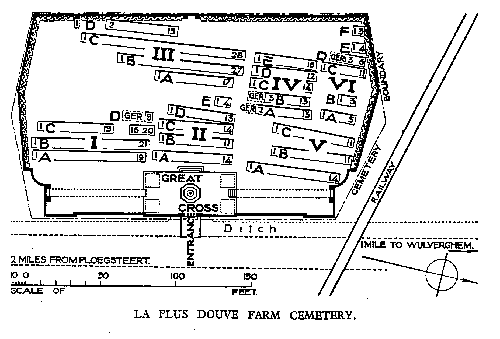
La Petite Douve Raid, November, 1915.
In the valley of the river Douve, north of Ploegsteert Wood, were two farms. La Petite Douve was the object of a successful raid by the 7th Canadian Infantry Battalion in November 1915 and La Plus Douve, which was generally within the Allied lines, was used at times as a battalion headquarters. This farm was also known as Ration Farm as battalion transport could approach it by night with rations. The cemetery was started by the 48th (South Midland) Division in April 1915 and was in use until May 1918, when the area was taken by the Germans.
Canadian Corps Front line in December, 1915. Private George Pass served in the 13th Canadian Infantry Battalion, part of the 3rd Canadian Infantry Brigade, which was positioned sw of Messines when he was killed.
13th Batallion - The Black Watch:
The Royal Highlanders of Canada gave birth to three Black Watch Battalions during the war. By the end of August, the regiment numbered over 1,000 men. As the numbers grew, volunteers from the Royal Highlanders were incorporated into the 13th Battalion. Over 60% of the initial recruits were of British origin. A large percentage were former British soldiers who had relocated to Canada at the turn of the century. While still in Canada, the 13th Battalion was placed in the 3rd Brigade of the 1st Division along with the 14th, 15th, and 16th battalions.
In October of 1914, the 1st Division departed for Great Britain. The Division remained in Great Britain for additional training until February 10th, 1915. On February 16, 1915, the unit departed for France. After spending time in France, in April of 1915, the battalion was used to reinforce British and Canadian lines in Ypres sector. The April 1915 battle for Ypres was the site of the first use of poison gas during the war. Despite the surprise of the German attack and their use of gas, the Canadian forces were able to stabilize their lines and fall back in good order to more defensible positions.
During its first actions of the war, the 13th Battalion lost 120 officers and 454 other ranks. The unit also won its first Victoria Cross (England's highest military honor) and the first VC for the Canadian Expeditionary Force (CEF). In his reports on the action, Sir John French was recorded as saying, "the bearing and conduct of the splendid Canadian troops averted a serious disaster."
During the remainder of 1915 and 1916, the 13th Battalion fought at battles in numerous locations including Festubert, Messines, Bailleul, Givenchy, Flanders, and the Somme.
Source:
Veterans Affairs Canada
In memory of
Private
ALFRED STEPHEN HUNTER
Service Number: 108298
September 28, 1894 - June 2, 1916
Undated photograph of Pte. Alfred S. Hunter taken between time of enlistment 10 April 1915 and his death 2 June 1916. Source: Tim Patterson, 7 Aug 2008 from the Robison Family photograph collections at Campburn Farm, Harvey Station, York County, New Brunswick.
Image was colorized by Tim Patterson Nov 2020.
Military Service
Service Number: 108298
Age: 21
Force: Army
Unit: *1st Canadian Mounted Rifles (Saskatchewan Regiment), Canadian Expeditionary Force (CEF)
*Listed as 3rd Canadian Mounted rifles in obituary.
Division: 8th Infantry Brigade, 3rd Canadian Division
Commemorated on Page 107 of the First World War Book of Remembrance.
Military Service Records:
When a recruit signed up for the Canadian Expeditionary Force in WW I he filled in an attestation paper that indicated his willingness to serve in the military and provided such information as date of birth, next of kin, height, weight, complexion, occupation, etc. As such these papers are of genealogical importance. The links below are to a scanned copy of the attestion papers of Alfred Hunter completed on 10 April 1915, in Medicine Hat, Alberta.
Date of Enlistment:
April 10. 1915, Medicine Hat, Alberta, Canada
Additional Information:
Private Alfred Stephen Hunter, was the son of James Alfred Hunter and Eleanor "Ellen" Robison, born 28 Sep 1894, Harvey, and died 2 June 1916, WWI, Defence of the Ypres Salient.
Newspaper obituary
Copied from newspaper obituary - 1916:
Harvey Station, N.B., June 21 -- Private Alfred S. Hunter, son of Mr Jas. A. Hunter, of Harvey Station, has been killed in action according to an official telegram received here last night by the father of the gallant soldier. He was a member of the 3rd Mounted Rifles, acting as infantry, having enlisted in that unit in the West.
Private Hunter was a young man of sterling habits, a graduate of the Provincial Normal School at Fredericton and went West in 1913, having secured a first-class teacher's license. He taught school in the West for about a year and enlisted for active service soon after the outbreak of the war. He was 22 years of age and is the first Harvey Station man to fall in the world war. Much sympathy is expressed for the bereaved family whose only surviving son is also in khaki, Private Charles W. Hunter being a member of the 104th Battalion at Sussex. Coun. S. B. Hunter of Harvey Station is an uncle of Private Hunter.
Cemetery:
No known grave.
Commemorated on the MENIN GATE (YPRES) MEMORIAL, Belgium.
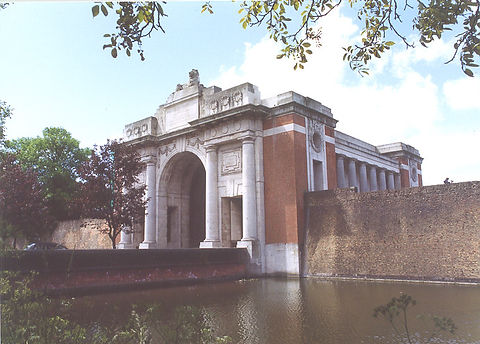

The Menin Gate Memorial is situated at the eastern side of the town of Ypres (now Ieper) in the Province of West Flanders, on the road to Menin and Courtrai. It bears the names of 55,000 men who were lost without trace during the defence of the Ypres Salient in the First World War.
Designed by Sir Reginald Blomfield and erected by the Imperial (now Commonwealth) War Graves Commission, it consists of a "Hall of Memory", 36.6 metres long by 20.1 metres wide. In the centre are broad staircases leading to the ramparts which overlook the moat, and to pillared loggias which run the whole length of the structure. On the inner walls of the Hall, on the side of the staircases and on the walls of the loggias, panels of Portland stone bear the names of the dead, inscribed by regiment and corps.
Carved in stone above the central arch are the words:
TO THE ARMIES OF THE BRITISH EMPIRE WHO STOOD HERE FROM 1914 TO 1918 AND TO THOSE OF THEIR DEAD WHO HAVE NO KNOWN GRAVE.
Over the two staircases leading from the main Hall is the inscription:
HERE ARE RECORDED NAMES OF OFFICERS AND MEN WHO FELL IN YPRES SALIENT BUT TO WHOM THE FORTUNE OF WAR DENIED THE KNOWN AND HONOURED BURIAL GIVEN TO THEIR COMRADES IN DEATH.
The dead are remembered to this day in a simple ceremony that takes place every evening at 8:00 p.m. All traffic through the gateway in either direction is halted, and two buglers (on special occasions four) move to the centre of the Hall and sound the Last Post. Two silver trumpets for use in the ceremony are a gift to the Ypres Last Post Committee by an officer of the Royal Canadian Artillery, who served with the 10th Battery, of St. Catharines, Ontario, in Ypres in April 1915.
Grave Reference:
Panel 30 and 32.
Menin Gate Plan
Source:
Veterans Affairs Canada
In memory of
Private
HARRY GUEST
July 25, 1892 - June 10, 1916

2491. Undated postcard photograph of Harry Guest (July 25, 1892 - June 10, 1916, aged 24, WWI in the defence of the Ypres Salient, no known grave. He was a British Home Child, sent from the Middlemore Homes in Birmingham, England on the SS Siberian in 1898 age 6 years. Emigration information source: Barbara McQuinn in Generations, The Journal of the New Brunswick Genealogical Society, Winter 2006, Volume 28, No. 4, page 15.
See back of postcard (2492 below) for postcard message.
Source: Collection of David Robison, Ottawa, Ontario. Rephotographed by Tim Patterson 13 June 2007.
Pte. Harry Guest
Military Service
Service Number: 444980
Age: 24
Force: Army
Unit: Canadian Infantry (Nova Scotia Regiment)
Canadian Expeditionary Force (CEF)
Division: 25th Battallion
Commemorated on Page 96 of the First World War Book of Remembrance
Military Service Records:
When a recruit signed up for the Canadian Expeditionary Force in WW I he filled in an attestation paper that indicated his willingness to serve in the military and provided such information as date of birth, next of kin, height, weight, complexion, occupation, etc. As such these papers are of genealogical importance. The links below are to a scanned copy of the attestion papers of Harry Guest completed on 17 June 1915, in Sussex, New Brunswick when hew was inducted into the 55th Batallion of the Canadian Expeditionary Force.
Date of Enlistment:
June 17, 1915 , Sussex, New Brunswick, Canada
Additional Information:
Private Harry Guest was the brother of Sidney O'Boyle of Evesbatch Court, Bishop's Frome, Worcester, England.
He was a British Home Child, sent from the Middlemore Homes in Birmingham, England on the SS Siberian in 1898 age 6 years. He was killed in battle on 10/06/1916 age 24. Information by Barbara McQuinn in Generations, The Journal of the New Brunswick Genealogical Society, Winter 2006, Volume 28, No. 4, page 15.
From the 1901 Census, Harry Guest was a lodger in the home of Andrew Robison and his wife Frances in Harvey Station, born 31 May 1895, England, and came to Canada in 1899. This census data is at odds with his army records and the information in McQuinn (2006; see above).
Died 10 June 1916, WWI, aged 24 in the defence of the Ypres Salient.
Cemetery:
No known grave.
Commemorated on the MENIN GATE (YPRES) MEMORIAL, Belgium.


The Menin Gate Memorial is situated at the eastern side of the town of Ypres (now Ieper) in the Province of West Flanders, on the road to Menin and Courtrai. It bears the names of 55,000 men who were lost without trace during the defence of the Ypres Salient in the First World War.
Designed by Sir Reginald Blomfield and erected by the Imperial (now Commonwealth) War Graves Commission, it consists of a "Hall of Memory", 36.6 metres long by 20.1 metres wide. In the centre are broad staircases leading to the ramparts which overlook the moat, and to pillared loggias which run the whole length of the structure. On the inner walls of the Hall, on the side of the staircases and on the walls of the loggias, panels of Portland stone bear the names of the dead, inscribed by regiment and corps.
Carved in stone above the central arch are the words:
TO THE ARMIES OF THE BRITISH EMPIRE WHO STOOD HERE FROM 1914 TO 1918 AND TO THOSE OF THEIR DEAD WHO HAVE NO KNOWN GRAVE.
Over the two staircases leading from the main Hall is the inscription:
HERE ARE RECORDED NAMES OF OFFICERS AND MEN WHO FELL IN YPRES SALIENT BUT TO WHOM THE FORTUNE OF WAR DENIED THE KNOWN AND HONOURED BURIAL GIVEN TO THEIR COMRADES IN DEATH.
The dead are remembered to this day in a simple ceremony that takes place every evening at 8:00 p.m. All traffic through the gateway in either direction is halted, and two buglers (on special occasions four) move to the centre of the Hall and sound the Last Post. Two silver trumpets for use in the ceremony are a gift to the Ypres Last Post Committee by an officer of the Royal Canadian Artillery, who served with the 10th Battery, of St. Catharines, Ontario, in Ypres in April 1915.
Grave Reference:
Panel 26 - 30
Menin Gate Plan
Source:
Veterans Affairs Canada

Cecil Arleigh Swan (middle)
Cecil Arleigh Swan, b. 23 Sep 1893, d. 26 Sep 1919. Son of Matthew Swan and Alberta Mowatt. Enlisted 17 June 1915 in 55th Battalion. He was wounded in head and face--from undated newspaper item. Enlistment papers give his birth date as 23 Sep 1894 (most likely Sep 1893 though as his sister Ivy Swan Wilson was born in Jan 1895). He tragically died in a hunting accident. Cecil was engaged to Flossie Coburn--she stayed single the rest of her life.
Undated newspaper item:
Pte. C. Swan
Mr Mathias (sic) Swan, Harvey, received official word, today, that his son, Pte. C. Swan, was wounded in the head and face. Pte. Swan enlisted with the 55th Battalion, in January 1915. He has another brother in an engineering battalion, stationed at St. John's, Que. It is hoped that his wounds are not serious.
From newspaper obituary - 1919:
Obsequies of the Late Cecil Swan
Harvey Station, York Co., NB, Sept 29 -- The funeral of the late Cecil Swan, of Harvey, was held from Harvey Presbyterian Church Sunday afternoon and was one of the largest funerals ever seen in Harvey. As stated in The Gleaner of Saturday, the late Cecil Swan was accidently shot by his brother while hunting for big game near Harvey Lake. The sad affair has cast a gloom over the whole community, and much sympathy is felt for the bereaved parents, brothers and sisters of deceased, and especially to the brother who fired the fatal shot, who is heartbroken about it.
Cecil was the eldest son of Matthew and Bertha (sic) Swan, of Harvey, and was the first man to enlist in Harvey with the 55th Battalion in June, 1915, going to England in the fall of 1915, and then to France, where he was in many engagements, being wounded twice; coming through all the hardships which a true soldier had to endure on the battlefields of France, arriving home this summer after over four years of absence. He was a quiet, inoffensive young man and was highly respected by the whole community. He was in his 26th year.
The funeral service was conducted by the Rev. J. F. MacKay, interment being made in Harvey cemetery. The pallbearers were four returned men in uniform and were: Ernest L. Hunter, Charles W. Hunter, Hugh Wilson, and Willard Wilson. Twenty-five returned soldiers marched behind the remains from the church to the cemetery.
Sgt. Major E.L. Hunter (Right)
Ernest Hunter was wounded twice before being transferred to a non-combat assignment. Although the Hunter family was from adjacent Acton the Hunter family intermarried into several Harvey families and played an important role in the community. Ernest Leslie Hunter, s/o Samuel Black Hunter and Victoria Kitchen, b. Harvey 10 Jun 1890, died Nov 1956 McAdam. Ernest's father had a store in Harvey, which he sold to Richard Davis in 1915 or 1916.
Copied from newspaper clipping - 1916:
York County Soldier Who Was Wounded, is Now on List as Dangerously Ill.
Sgt. Major W. E. Hunter, Son of Ex-warden S. B. Hunter, is Worse. Shot at Close Of Fine Charge. Other New Brunswick Soldiers in the List of Casualties Today.
Ex-Warden Samuel B. Hunter, of Harvey Station, received a telegram last night stating that his son, Sergt. Maj. W. E. Hunter, who was wounded on October 21st, is now on the dangerously ill list.
Sergt. Major Hunter, who gave up a good position in the Marine and Fisheries Department to enlist with an infantry battalion at Ottawa, was shot through the shoulder just as his battalion gained their objective after a charge of 400 yards over open country on the Somme front. The following day he was able to write a letter to his father in which he deprecated the extent of his wounds and said he thought he would soon be ready to go back to the front again. The latest news has caused his family and friends much uneasiness.
His brother, Pte. Ernest Hunter, was also wounded some time ago but is now holding a clerical position on Lieut. Col. H. F. McLeod's staff in England, and will probably not return to France again for some time if at all.
Copied from newspaper obituary - 1956:
McAdam Resident Widely Mourned
McAdam -- A citizen well-known in both community and church circles, Ernest Leslie Hunter, passed away at his home on Saunders Road, McAdam, Tuesday morning after a brief illness.
Mr Hunter was born at Harvey Station, June 10, 1890, a son of Victoria (Kitchen) Hunter and the late Samuel B. Hunter. He moved to McAdam in 1919 where he entered the service of Canada Customs and retired in 1955. He will long be remembered by travelers on the Boston to Saint John train with whom he made many friends by his friendly and congenial manner.
A veteran of the First World War, he went overseas with the 55th Battalion in 1915. After suffering wounds twice, he was transferred to the 104th Battalion.
He was a staunch member of St. George's Anglican Church, and in the community he was a willing worker. He was a member of the McAdam Home and School Association, McAdam Branch of the Canadian Legion, No. 7, Curling Club, Ashlar Lodge No. 36, F and AM. Until shortly before his death, he held the office as general manager of the McAdam Credit Union since it was formed in 1937.
Surviving are his widow, Eunice Valeria (Williams); one son, James, McAdam; one daughter, Ann, on the staff of the Andover Regional School; his mother; one brother William, Ottawa, and one sister (Edna) Mrs Percy Pheeney, McAdam. Funeral will be held on Thursday, with prayers at the home at 2 p.m. and at St. George's Anglican Church at 2:30 p.m. Interment will be in Rockland Cemetery.
photo gallery
In memory of
Private
ALEXANDER "SANDY" GRIEVE
August 9, 1882 - March 1, 1917
Military Service
Service Number: 687337
Age: 35
Force: Army
Unit:Canadian Infantry (Central Ontario Regiment), Canadian Expeditionary Force (CEF)
Division:54th Batallion (the Kooteneys), 4th Division
Commemorated on Page 247 of the First World War Book of Remembrance.
Military Service Record:
Library and Archives Canada has digitized and made available the service records for all soldiers of the Canadian Expeditionary Force (CEF) in World War I. The files of CEF members consist of documents dealing with enlistment, training, medical and dental history, hospitalization, discipline, pay, medal entitlements and discharge or notification of death. The links below are to a scanned copy of the military records of Alexander "Sandy" Grieve from that time that he enlisted on 19 January, 1916 (28th Jan scratched out), in Kamloops, British Columbia until his death in action on 1 March 1917.
Date of Enlistment:
January 19 (28th Jan scratched out) 1916, Kamloops, British Columbia, Canada
Additional Information:
Private Alexander "Sandy" Grieve was the son of George Alexander Smith Grieve and Harriett "Hattie" Pass, The family moved to BC in 1890 (McEwen, 2004). Born 9 Aug 1881, Harvey, and died 1 Mar 1917, WWI, France.
"Sandy was a switchman for the CPR living in Vancouver with his parents on West 7th Avenue in 1907 and 1908. In 1911, he was a yard foreman living on Smithe Street. Ref.--City Directories for Vancouver.
"From Sandy's service record, we learn that Sandy was living with his father in Penticton, BC, when he enlisted in Kamloops in 1916 and his trade was a brakeman. He enlisted for the Canadian Overseas Expeditionary Force on 19 Jan (28th Jan scratched out) 1916. He was assigned to the 172nd Battn with the rank of Private. He embarked from Canada 25 Oct 1916 and arrived in England on the SS Maurentania, 31 Oct 1916. On 5 Dec 1916 he proceeded to Bramshott, France, with the 54th Battn arriving two days later. On 15 Dec 1916 he left Bramshott for action in the field. He was killed in action 1 Mar 1917." (McEwen, 2004, p. 85).
McEwen, W. 2004. The Grieve Saga: The Family of William Grieve & Eleanor Turnbull and their Descendants (1794-2004) from Harvey, NB and the Comox Valley, BC" (ISBN 0-9735932-0-2),
Cemetery:
Cabaret-Rouge British Cemetery, Souchez, Pas de Calais, France
Grave Reference:
XIII. D. 9
Location:
Souchez is a village in the Department of the Pas-De-Calais, 3.5 kilometres north of Arras on the main road to Bethune. It lies in the valley of the Souchez river, between the Lorette Bridge to the west and Vimy Ridge to the east. The Cabaret-Rouge British Cemetery is about 1.5 kilometres south of the village on the west side of the D937 Arras-Bethune Road.
On 26 September 1915, Souchez was taken from the Germans by French troops, who handed the sector over to Commonwealth forces the following March. The village was completely destroyed. The "Cabaret Rouge" was a house on the main road about 1 kilometre south of the village, at a place called Le Corroy, near the cemetery. On the east side, opposite the cemetery, were dugouts used as battalion headquarters in 1916. The communication trenches ended here, including a very long one named from the Cabaret. The cemetery was begun by Commonwealth troops in March 1916, used until August 1917 (largely by the 47th (London) Division and the Canadian Corps) and - at intervals - until September 1918; these original burials are in Plots I to V inclusive. It was greatly enlarged after the Armistice when more than 7,000 graves were brought in from the battlefields of Arras and from 103 other burial grounds in the Nord and the Pas-de-Calais. The cemetery now contains 7,655 Commonwealth burials of the First World War, more than half of them unidentified. There is also one Second World War burial. On 25 May 2000, the remains of an unidentified Canadian soldier were entrusted to Canada at a ceremony held at the Vimy Memorial, France. The remains had been exhumed by staff of the Commonwealth War Graves Commission from Cabaret-Rouge British Cemetery, Souchez, Plot 8, Row E, Grave 7. The remains were laid to rest within the Tomb of the Unknown Soldier, in a sarcophagus placed at the foot of the National War Memorial, Confederation Square, Ottawa, Canada.
Number of identified casualties:
3187

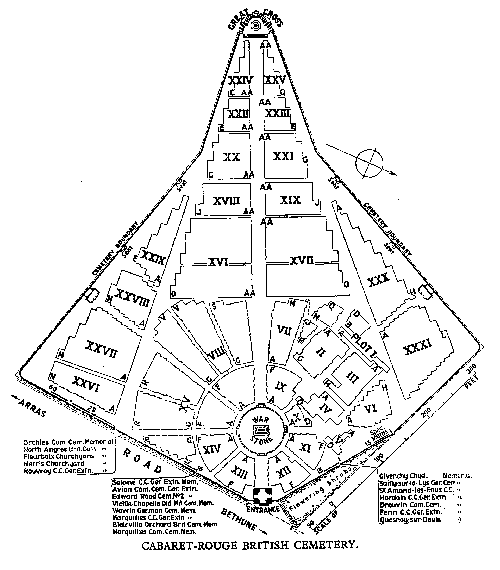
Disastrous Trench Raid Vimy Ridge (1 Mar 1917)
During the early months of 1917 the Canadian Corp was training for it's famous assault on Vimy Ridge that would take place on April 9, 1917. In preparation for the battle to come the Canadians continually probed the German defenses via trench raids to map the terrain, assess enemy strength and to obtain intelligence. The Canadian Corps in fact "owned" No-Man's Land in the night hours, patrolling right into the German trenches at will. Some raids were on a very large scale though, and not always successful. Such was the case of the Division-scale raid launched in the early hours of 1 Mar 1917 when 1700 men of the Canadian 4th Division launched a phosgene and chlorine gas attack on Vimy Ridge in support of a major trench raid. The 54th Batallion contributed 15 officers and 390 men of other ranks, including Private Sandy Grieve. As outlined in the transcript of the 54th Battalion War Diary entries below the attack was a disaster. The gas attack was ineffective against the German defenders, supporting artillery fire fell short of the German lines and the soldiers foundered on uncut wire emplacements. The soldiers were mowed down by heavy machine gun fire and heavy rifle fire before they could make any headway. Many who dived into shell craters to escape the gun fire were often killed by their own phosgene gas as it tended to accumulate in any hollow. By the time the attack ended 13 of the 15 officers were dead or wounded including the Batallions experienced and decorated commander Lieut. Col. A.H.G. Kemball, CB, D.S.O. Amongst Other Ranks there were 77 dead, 126 wounded and 10 missing. Private Sandy Grieve was amongst the dead. On the next day, 2 Mar 1917, a short informal truce was arranged with the Germans to recover dead and wounded. Soldiers from both sides helped recover the dead and shared cigarettes and stories before the higher ups got wind of the cease fire and put a stop to it by noon. Never-the- less not one shot was fired in that sector for the rest of the day. As a footnote the 4th Division was so weakened by the losses taken by the 54th Btn and other units that it had not fully recovered by the time of major attack on Vimy Ridge on 9 Apr 1917. This resulted in the 4th Division having difficulty taking its objectives.
A very comprehensive discussion of the background planning, implementation and outcome of the 1 March trench raid is found in Pierre Berton's excellent book "Vimy" p. 126-135, which describes the significance of the Battle of Vimy Ridge in Canada's march to full nationhood.
Berton, P. 1986. Vimy, McClelland and Stewart, Toronto. ISBN 0-7710-1339-6, 336 p.
Extract From War Diary 54th Batallion, 4th Division, Canadian Expeditionary Force



Vimy Ridge 1st March 1917
The Battalion took part in a Divisional Gas Attack. Gas being discharged on the 11th and 12th Canadian Infantry Brigade's fronts. Object - to destroy enemy works and gain information. The 2nd Canadian Division on our right (22nd Batn.) cooperated with a smoke barrage. The 75th Cdn Inf Bn on our left. 15 officers and 390 OR took part. Programme as follows.
First Gas discharge, 3 am. Second Gas discharge 4:45 am, Advance from Assembly Trench to No-Man's Land, 5:15 am; Assault 5:40 am. Owing to the unfavourable wind second discharge of gas did not take place on the Brigade frontage. Enemy retaliated as first wave was dicharged with heavy machine gun fire and gas shells, quieting down about 3:45 am. Advance to No-Man's Land carried out without serious opposition but heavy rifle and machine gun fire opened all along the front as the Battalion deployed in No Mans Land. First discharge of gas apparently had no effect on the enemy. In the face of heavy rifle and machine gun fire assault was carried out at 5:40 am, but owing to strong wire entanglements before their front line no headway could be made and owing to the retirement of the Battalion on our left we conformed shortly after.
Artillery barrage was not sufficiently consecrated and caused no slack during of the enemy's fire. Was registered correcly on our right but very short on our left & centre, where the chief casualties occurred. - Casualties - Officers. 6 killed 7 wounded. Other Ranks 77 killed, 126 wounded, 10 missing.
At night efforts were made to bring in wounded from No-Man's Land but owing to the alertness of the enemy had to be abandoned. -
Casualties in officers: Killed:- Lieut. Col. A.H.G. KEMBALL, CB, D.S.O., Major F.T. LUCAS, Capt. N.L. TOOKER, Lieut.s A.B. JACKSON, W.A. REDDOCK, J.L. EVANS. - Wounded Capt. R.B.M CAMERON, Lieuts. R.J. HOSIE, M.C., H.F.G. LETSON, W.L. MAWHINNEY, A.F. GRAVES, G.W. FOOTE, H.E. JOHNSON
Vimy Ridge 2nd
Weather fine. Battalion relieved by 87th Canadian Inf. Bn. & proceeded to MUSIC HALL LINE. "B", "C" and "D" Comps. in MUSIC HALL. "A" Comp moved up in support of the 87th Battalion. At night parties of Scouts and Volunteers brought in several bodies from No - Man's Land. - Lieut W.L. Mawhinney died of wounds.
Music Hall Line 3rd
Weather fine - Armistice arranged with enemy whereby it was agreed both sides should clear No Man's Land of dead bodies. 43 bodies of our own men recovered, amongst them were Lieut Col. KEMBALL, Major LUCHS and Capt. TOOKER. Armistice terminated at 12 noon. "D" Comp. moved into the BATOLLE LINE north of WORTLEY.
Music Hall Line 4th
Weather fine. Pre-arranged armistice cancelled. Burying party under Lieut. J.T. SMEETON buried several bodies in No-Man's Land under cover of darkness. Funeral of Lieut. Col. A.H.G. KEMBALL, CB, D.S.O., Major F.T. LUCAS and Capt. N.L. TOOKER held at VILLERS AU BOIS at 2 pm and attended by Maj. General D. WATSON, C.B., Col. E. IRONSIDES, D.S.O., Lt. Col. E. de B. PANET and Lt. Col. R.D. Davies and all available officers of the Battalion. Firing party supplied from 5th Btn.
Source:
Veterans Affairs Canada
National Archives of Canada
In memory of
Private
ALBERT J. (MOWAT) MOWATT
June 16, 1881 - April 9, 1917
from the collection of Katie Carmichael
Military Service:
Service Number: 703806
Age: 28
Force: Army
Unit: Canadian Infantry (Central Ontario Regiment) Canadian Expeditionary Force
Division: 102nd Battallion
Commemorated on Page 298 of the First World War Book of Remembrance.

Military Service Records:
When a recruit signed up for the Canadian Expeditionary Force in WW I he filled in an attestation paper that indicated his willingness to serve in the military and provided such information as date of birth, next of kin, height, weight, complexion, occupation, etc. As such these papers are of genealogical importance. The links below are to a scanned copy of the attestion papers of Albert Mowatt completed on 1 February 1916, in Thurlow, British Columbia, when he was inducted into the 102nd Battalion (Comox-Atlin) of the Canadian Expeditionary Force.
Date of Enlistment:
Feburary 1, 1916, Thurlow, British Columbia, Canada
Additional Information:
Private Albert Mowatt born 16 Jun 1881, son of Andrew Mowatt and Isabella Watt, Harvey, NB. Albert left Harvey in 1903 to work as a logger and machinist. Before enlistment his last address was Thurlow, British Columbia. He enlisted in the Canadian Expeditionary Force on 1 February 1916 in Thurlow. He had 3-years previous military service with the 71st Regt. Of New Brunswick. On 5 February, 1916 he was taken on strength in the 102nd Battalion. He was promoted to CPL on 26 February, 1916. He sailed for Britain from Halifax on 18 June, 1916 aboard the Empress of Britain and made landfall on 28 June 1916. The batallion proceeded to Camp Bramshott, where they obtained additional training before departing for France on 11 August, 1916. He received a minor shrapnel wound to the head on 10 November 1916 and had returned to duty three days later on 13 November 1916. He Died 9 Apr 1917, WWI, Battle of Vimy Ridge, northern France.
Cemetery:
Canadian Cemetery No. 2, Pas de Calais,France
There is a Maple Leaf on the cemetery gate although the burials here are not exclusively Canadian. As well as the many known Canadian and British soldiers buried here there are also many unknown burials. In fact, more than two-thirds of those buried in the cemetery are "Known Unto God", as the inscription on their headstones reads. Although the cemetery was started just after the Canadians took Vimy Ridge in April 1917, the majority of the graves were moved here from elsewhere, over a period of years after the Armistice. They were either moved from smaller burial grounds, isolated graves or else were bodies recovered from the battlefield as the years went by. This explains the high proportion of unknown burials.
Location:
The Canadian Cemetery No. 2 is about 2.5 kilometres north of the village of Neuville-St. Vaast. The village is about 6 kilometres north of Arras and 1 kilometre east of the main road from Arras to Bethune. The cemetery is on a spur road turning left from the road to Givenchy-en-Gohelle, about 1 kilometre south of the Canadian Memorial at Vimy.
Grave Reference:
Sp. Mem.

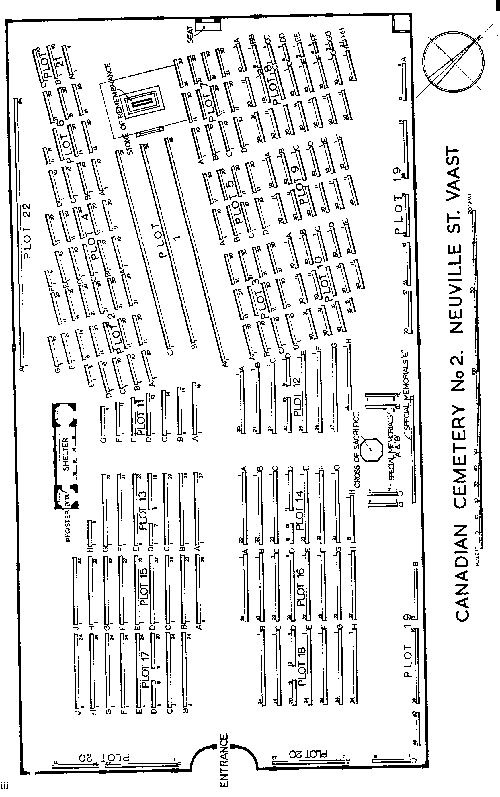
Newspaper obituaries
Copied from newspaper item (1917):
Harvey Man Killed.
Mr and Mrs Andrew Mowatt, of Harvey Station (N.B.) received a message last week informing them that their eldest son, Albert, who was a soldier in one of the Canadian regiments now serving in France, had been killed in one of the recent battles there. The deceased soldier left his home here about fourteen years ago and went to British Columbia, where he engaged in lumbering but shortly after the outbreak of the war enlisted in one of the British Columbia units. He is the fifth Harvey boy who has made the supreme sacrifice.
Undated and unknown newspaper obituary
Hartley Mowatt, a son of Andrew Mowatt, who went to Europe as a member of the Canadian contingent of three years ago returned home last evening. Private Mowatt saw much active service in France and Flanders and was through some of the hardest of the fighting, but escaped severe injury. His brother Albert who enlisted some time before, fell facing the Huns in Belgium.

The Battle of Vimy Ridge (9 -12 Apr 1917)
Vimy, located in northern France, was one of the most heavily defended points on the entire Western Front and was thought to be an impregnable fortress. The ridge was a key asset for most of World War I. Stretching from the town of Vimy to Givenchy-en-Gohelle, it was a crucial feature that allowed the Germans to control much of the surrounding territory. For the Allies, it was the only major barrier keeping them from the wide open Lens-Douai plain.
The German army fortified it with tunnels, three rows of trenches behind barbed wire, massive amounts of artillery, and numerous machine gun nests. The French and British had suffered thousands of casualties in previous attempts to take it; the French alone lost 150,000 men in 1915.
The Allied commanders decided to launch another assault in 1917. The duty was given to the still relatively fresh, but previously successful, Canadians. For the first time, all four divisions of the Canadian Corps were brought together. They were joined by the British 5th Infantry Division.
The Canadian Corps' commanders were determined to learn from the mistakes of the French and British and spent months planning their attack. They built a replica of the ridge behind their lines, and trained using platoon-level tactics, including issuing detailed maps to ordinary soldiers rather than officers or NCOs alone. Each platoon was given a specific task, rather than vague instructions from an absent general. They also employed older techniques such as the detonation of large mines under the German trenches
Map of Vimy Ridge
On April 2, 1917, the Canadian Corps initiated the largest artillery barrage in history up to that point. They shelled the German trenches for a week, using over one million shells. The German artillery pieces were hidden behind the ridge, but by observing the sound and light from their firing, the Canadians were able to locate and destroy about 86% of the German guns. The Canadians also made many night trench raids during this week, although General Arthur Currie thought this was a stupid risk and a waste of men. The German troops called this period the "Week of Suffering". The attack was so loud, it could be heard in London.

It is said that upon learning of the victory, a French soldier exclaimed, "C'est impossible!" ("It's impossible!"), and upon learning it was the Canadians who had done it, changed his answer to "Ah! les Canadiens! C'est possible!" ("Ah! The Canadians! It is possible!").
By April 12, the Canadians controlled the entire ridge, at a cost of 3,598 men killed and 7,104 wounded. The German Sixth Army, under General Ludwig von Falkenhausen, suffered approximately 20,000 casualties. The Canadians also took 4,000 Germans as prisoners of war. The loss of the ridge forced the Germans to retreat to the lower plains that were far more difficult to defend. The attack and objective had only limited grand-strategic significance, and as the simultaneous British and Australian attack to the south was unsuccessful, very little was actually achieved after the Canadian victory.
However, in a war in which, battle after battle, thousands died for gains measured in yards, the breakthrough had tremendous tactical significance. It relieved the city of Arras from the immediate threat of attack and proved that the front lines could be moved forward once again, after years of bloody stalemate. Vimy Ridge was the first Allied victory in almost a year and a half and it was especially demoralizing for the Germans who had viewed the ridge as one of their most impregnable strongpoints.
Source:
Wikipedia, Veterans Affairs Canada
At dawn on Easter Monday, April 9, the 30,000-man Canadian Corps attacked, behind a creeping barrage. This tactic had been used earlier by the British at the Battle of the Somme, but there it had outpaced the soldiers. The Canadians perfected the technique. The troops walked across no man's land, just behind a continuous line of shells (an improvement over previous battles, in which both sides had often shelled their own troops). Several new and untested methods of counter-battery fire were also used successfully at the start of the battle. This disabled a large portion of the German artillery and protected the advancing infantry. The Canadians also used a new technique they called "Indirect Fire", which utilized machine guns to pin German troops down in their trenches and provide cover for their own troops.
After less than two hours, three of the four Canadian divisions had taken their objectives; the fourth division, however, was held up by machine gun nests on the highest point of the ridge, known as Hill 145. The 87th Battalion suffered 50% casualties. The 85th Nova Scotia Highlanders, who had been intended to function in a supply and construction role, were sent in as reinforcements and the hill was captured by the end of the day.

In memory of
Gunner
MILLARD JOSEPH ROBISON
Service Number: 1251032
April 16, 1897 - November 19, 1917
Cropped version of phototraph to left below taken some time in early 1915 of Gunner Millard Robison between time of enlistment and deployment overseas. Millard is standing in front of what his nephew Al Robison describes as what "we always knew as Aunt Alma's house, on 6th Avenue A, but which was in fact the first house our Grandpa Robison had built in Lethbridge. He and Grandma and most of the kids presumably lived there until he built the house at 2004 Seventh Avenue South. Source: Tim Patterson, 7 Aug 2008 from the Robison Family photograph collections at Campburn Farm, Harvey Station, York County, New Brunswick.
Photo Gallery
The three images of Millard wtih people in them were taken at Campburn Farm in Harvey with his Grandma Robison (nee Eleanor "Jane" Herbert). Millard's nephew Al Robison vividly remembers "Uncle Albert -- our Grandpa Robison's younger brother -- telling me when I met him in Harvey on my first visit there about the joyful celebration they all had down at the train station when Norman and Millard came though on their way to Halifax to board the ship for England. Their idea was to go over there and give the Huns "a good kick in the ass" and then be back in time for Christmas. That was apparently a common view throughout Canada in 1915, that the troops would be home by Christmas." Source: Tim Patterson, 7 Aug 2008 from the Robison Family photograph collections at Campburn Farm, Harvey Station, York County, New Brunswick.
Military Service
Service Number: 1251032
Age: 21
Force: Army
Unit: Canadian Field Artillery
Division: 8th Bde.
Commemorated on Page 318 of the First World War Book of Remembrance.
Military SErvice Records
Additional Information:
Gunner Millard Robison, was the son of George Robison and Margaret "Maggie" Embleton. The family moved to Aerta in 1911, altough all of their children were born in Harvey. Millard Roblson was born 16 Apr, 1897, moved to Lethbridge, Alberta with his family when he was 14, and died 19 Nov 1917, WWI, just after the Battle of Passchendaele (12 Oct 1917 - 10 Nov 1917), Belgium.
Cemetery:
Dozinghem Military Cemetery, Belgium.
Location:
Dozinghem Military Cemetery, Belgium. is located 12 Km west of Ieper town centre on the Leeuwerikstraat, a road leading from the N308 connecting Ieper to Poperinge. From Ieper town centre the Poperingseweg (N308), is reached via Elverdingsestraat then directly over two small roundabouts in the J. Capronstraat. The Poperingseweg is a continuation of the J. Capronstraat and begins after a prominent railway level crossing. On reaching the town of Poperinge the right hand turning onto the R33 Oostlaan leads to the left hand junction with Veurnestraat. The Veurnestraat leads to the first right hand turning onto the Sint Bertinusstraat. The third right hand junction along this road leads onto Krombeekseweg, towards the village of Krombeke. 3.5 Km along this road which at this point is known as Leeuwerikstraat, lies the signpost indicating the right hand turning onto a woodland track leading to Dozinghem Military Cemetery, Belgium.. The cemetery is located a short distance along the track.
Westvleteren was outside the front held by Commonwealth forces in Belgium during the First World War, but in July 1917, in readiness for the forthcoming offensive, groups of casualty clearing stations were placed at three positions called by the troops Mendinghem, Dozinghem and Bandaghem. The 4th, 47th and 61st Casualty Clearing Stations were posted at Dozinghem and the military cemetery was used by them until early in 1918. There are now 3,174 Commonwealth burials of the First World War in the cemetery and 65 German war graves from this period. The cemetery also contains 73 Second World War burials dating from the Allied withdrawal to Dunkirk in May 1940. The cemetery was designed by Sir Reginald Blomfield.
Casualty Details: UK 3058; Canada 61; Newfoundland 19; Australia 6; New Zealand 14; South Africa 15; Germany 65; Total Burials: 3239
Grave Reference:
XIV. C. 10

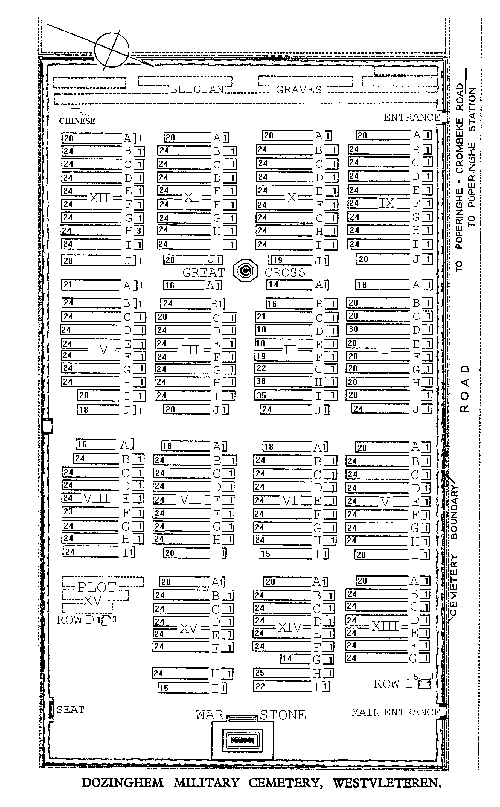
The 1917 Battle of Passchendaele, also known as the Third Battle of Ypres or simply Third Ypres, was one of the major battles of World War I, fought by British, ANZAC and Canadian soldiers against the German Army. The battle was fought for control of the village of Passendale, (Passchendaele on maps of that time), near the Belgian town of Ypres in West Flanders. The plan was to drive a hole in the German lines and advance to the Belgian coast and capture the German submarine bases there. It would have created a decisive corridor to be opened in a crucial area of the front, and it would also take pressure off the French forces. After the disastrous Nivelle offensive, the French Army was suffering from extremely low morale, which resulted in such an increase in cases of mutiny and misconduct as to threaten the field-worthiness of entire divisions.
The land on which the battle took place was largely reclaimed marshland, swampy even without rain. The extremely heavy preparatory bombardment by the British tore up the surface of the land, and heavy rain from August onwards produced an impassable terrain of deep "liquid mud", in which an unknown number of soldiers drowned. Even the newly-developed tanks bogged down. The Germans were well entrenched, with mutually-supporting pillboxes which the initial bombardment had not destroyed. The town of Passendale was finally taken by the Canadian forces, but the combined casualties of the allies was almost a half of a million men, with about a quarter million men lost by the Germans.
Passendale is the modern Dutch spelling of the village, and the old name of Passchendaele is now used only to refer to this battle and by locals who pronounce it in West Flemisch dialect. This term should properly apply only to the later actions of the battle in October–November 1917, but has come to be applied also to the entire campaign from July 31. After three months of fierce fighting, the Canadian Corps took Passchendaele on November 6 1917, ending the battle. In the history of World War I, the term 'Passchendaele' has become a symbol of the extreme brutality of industrial warfare.
First Battle of Passchendaele
The First Battle of Passchendaele, on October 12 1917 began with a further Allied attempt to gain ground around Poelkapelle. The heavy rain again made movement difficult, and artillery could not be brought closer to the front owing to the mud. The Allied troops were tired, and morale was suffering. Against the well-prepared German defences, the gains were minimal and there were 13,000 Allied casualties.
By this point in the battle there had already been 100,000 Allied casualties, with only limited gains and no strategic breakthrough.
Second Battle of Passchendaele
At this juncture two divisions of the Canadian Corps were moved into the line to replace the badly depleted ANZAC forces. After their successes at Vimy Ridge and the Battle of Hill 70, the Canadians were considered to be an élite force and were sent into action in some of the worst conditions of the war.
Upon his arrival, the Canadian Commander-in-Chief General Sir Arthur Currie expressed the view that the cost of the objective would be sixteen thousand casualties. While Currie viewed this figure as inordinately high in comparison to the value of the objective, Haig was conditioned to accept high casualty rates after years of allied losses in the hundreds of thousands. He therefore ordered the offensive to proceed over Currie's objections.
The Canadians moved into the line during mid-October, and on October 26 1917, the Second Battle of Passchendaele began with twenty thousand men of the Third and Fourth Canadian Divisions advancing up the hills of the salient. It cost the Allies twelve thousand casualties for a gain of a few hundred yards.
Reinforced with the addition of two British divisions, a second offensive on October 30 resulted in the capture of the town in blinding rain. For the next five days the force held the town in the face of repeated German shelling and counter-attacks, and by the time a second group of reinforcements arrived on November 6, four-fifths of two Canadian divisions had been lost.
Their replacements were the Canadian First and Second Divisions. German troops still ringed the area, so a limited attack on the 6th by the remaining troops of the Third Division allowed the First Division to make major advances and gain strong points throughout the area.
One such action on the First Division front was at Hill 52; the Tenth Battalion, CEF were called out of reserve to assist an attack on Hill 52, part of the same low rise Passchendaele itself was situated on. The Battalion was not scheduled to attack, but the Commanding Officer of the Tenth had wisely prepared his soldiers as if they would be making the main assault – a decision that paid dividends when the unit was called out of reserve. On 10 November 1917, the Tenth Battalion took the feature with light casualties.
A further attack by the Second Division the same day pushed the Germans from the slopes to the east of the town. The high ground was now firmly under Allied control. Although the major activity associated with Passchendaele ended by 10 November 1917 the Canadian Field Artillery continued harrassing fire on the German Army. Gunner Millard Joseph Robison died on 19 November most likely due to counter battery activity, or from an accident.
Source:
Veterans Affairs Canada
















